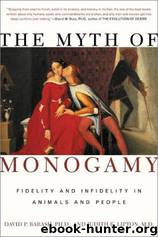The Myth of Monogamy: Fidelity and Infidelity in Animals and People by David P. Barash; Judith Eve Lipton

Author:David P. Barash; Judith Eve Lipton
Language: eng
Format: mobi, epub
ISBN: 9780805071368
Publisher: Owl Books
Published: 2002-04-16T05:00:00+00:00
llliam James is said to have composed this ditty, although with insights inspired by opium rather than evolutionary biology:
Higamous hogamous, woman monogamous Hogamous higamous, man is polygamous.
What earthly good can come of it?
why does monogamy occur at all? 117
or more additional females.) Nonetheless, a male's EPCs can still have consequences for his social mate, and nearly always these consequences are negative. The male may be injured during his gallivanting and thus less able to help with his domestic responsibilities. He may contract a sexually transmitted disease and then infect his mate. He may elect to leave his mate, having discovered a more desirable partner. And--probably the greatest risk, because the most likely--he might find himself devoting time and effort to his lover's offspring, providing benefits that are deducted from his "official" mate and her offspring.
This risk is greater yet in species that are sometimes monogamous, sometimes polygynous--that is, in which males occasionally succeed in transforming an EPC conquest into an additional, full-time reproductive partner. We can therefore expect that in such cases, females will be strongly motivated to keep their males from engaging in EPCs--and even more strongly inclined to prevent their switching from monogamy to polygyny. The end result? Males may seek multiple mates and even polygyny but end up with monogamy because of the intervention of their females, who won't let them bring their girlfriends home.
In a species of lizards common in the Southwest, females defend small territories from which they exclude other females. Males cannot monopolize more than one female because females are so antagonistic to one another that their territories are dispersed.
In most such cases, it appears that females are moved to keep other females at bay when the males have something of value--usually, parental care--to contribute. But sometimes, even when males provide virtually nothing (besides sperm) to their offspring, monogamy remains the most frequent system; for example, among willow ptarmigans, grouse-like residents of mountain and arctic habitats, it seems likely that females are too dispersed to permit bigamy. These animals may also be too aggressive toward each other to accommodate a second female within their domain ... much as the male might want to.
It isn't clear what the "married" female ptarmigan would lose by permitting her husband to have a second wife, since his contribution is essentially nil; probably it isn't a matter of having to share him, but, rather, having to share limited food resources with another female and her brood. Similarly, among eastern bluebirds (normally monogamous), males provide little more than a nesting cavity. WTiat generates social monogamy in the bluebird world is the fact that suitable nest-sites are few and far between, and--acting in their own self-interest--female bluebirds won't share them. (It must be pointed out, however, that polygynous females do not always suffer an obvious cost when their male takes another mate; it is possible, that in such cases, males are able to add one or more additional females to
118 the myth of monogamy
their harems precisely because doing so imposes no extra cost to existing females.
Download
The Myth of Monogamy: Fidelity and Infidelity in Animals and People by David P. Barash; Judith Eve Lipton.epub
This site does not store any files on its server. We only index and link to content provided by other sites. Please contact the content providers to delete copyright contents if any and email us, we'll remove relevant links or contents immediately.
Rewire Your Anxious Brain by Catherine M. Pittman(18288)
Talking to Strangers by Malcolm Gladwell(12865)
The Art of Thinking Clearly by Rolf Dobelli(9908)
Mindhunter: Inside the FBI's Elite Serial Crime Unit by John E. Douglas & Mark Olshaker(8699)
Becoming Supernatural by Dr. Joe Dispenza(7831)
Change Your Questions, Change Your Life by Marilee Adams(7371)
The Road Less Traveled by M. Scott Peck(7275)
Nudge - Improving Decisions about Health, Wealth, and Happiness by Thaler Sunstein(7238)
The Lost Art of Listening by Michael P. Nichols(7157)
Mastermind: How to Think Like Sherlock Holmes by Maria Konnikova(6936)
Enlightenment Now: The Case for Reason, Science, Humanism, and Progress by Steven Pinker(6869)
Win Bigly by Scott Adams(6823)
The Way of Zen by Alan W. Watts(6288)
Daring Greatly by Brene Brown(6221)
Big Magic: Creative Living Beyond Fear by Elizabeth Gilbert(5349)
Grit by Angela Duckworth(5295)
Men In Love by Nancy Friday(4963)
Ego Is the Enemy by Ryan Holiday(4953)
Altered Sensations by David Pantalony(4863)
